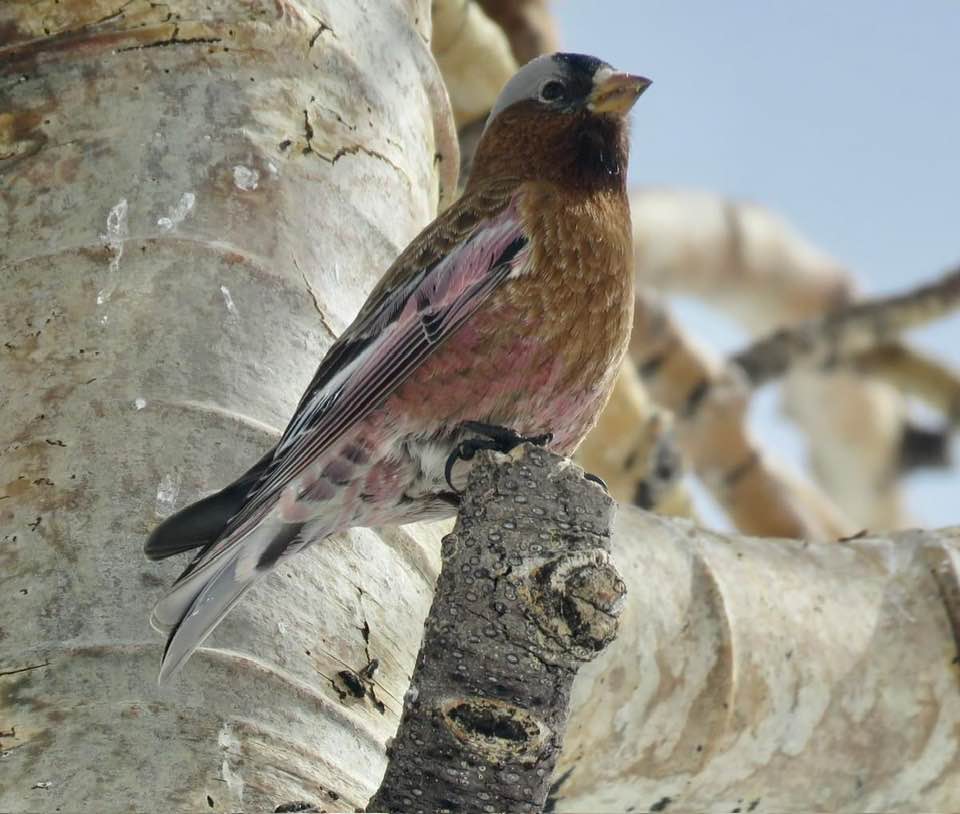Gray-crowned Rosy-Finch
Leucosticte tephrocotis Swainson (1832)

Appearance
Size: L 6.25″
Shape: Fairly small, deep-bellied, small-headed with a short conical bill and moder- ate-length notched tail. Long primary projection past tertials; crown peaked when crest raised. Bill longest among rosy-finches.
Both Sexes: Breast feathers warm brown to cinnamon-brown without blackish centers and with variable thin pale fringes; blackish forecrown; pale silvery-gray hindcrown, which extends to the eye and sometimes through the cheek (see Sub- species), contrasts strongly with surrounding warm brown back; limited rose on brownish rear belly.
Adult Male: Bright pink on wings and more extensive bright pink on belly.
Adult Female: Duller less extensive pink on wings and belly; forecrown less exten- sively black. Both sexes have blackish bill in summer, yellowish in winter (f. bill color changes to yellow about 1 month earlier than m.).
1st Year: Like ad. But greater secondary coverts and primary edges mostly to all whitish (ad. pink in these areas); little or no pink on underparts.
Juv: (June–Aug.) Grayish-brown overall with pinkish to buff wingbars.
Natural History
Gray-crowned Rosy-Finches (along with their cousins, Brown-capped Rosy-Finches and Black Rosy-Finches) are likely the highest elevation breeding birds in North America. Gray-crowns even nest on the slopes of mountains such as Denali, the highest mountain on the continent at 20,310 feet. Of these rosy- finch cousins, Gray-crowned Rosy-Finches also have the broadest range. They breed at high elevation in the Brooks Range, Rocky Mountains, Cascades, and Sierra.
Taxonomy
6 taxa separate into 3 larger coastal, tundra-dwelling Gray-cheeked subspecies(Gray-cheeked Group) and 3 smaller alpine-interior Brown-cheeked subspecies (Brown-cheekedGroup).
Gray-cheeked Group: Large to medium-small; gray cheek includes L. t. griseonucha, L. t.umbrina, and L. t. littoralis. Characterized by uniformly gray auriculars and hindcrown; umbrina and griseonucha very large (largest taxa in genus Leucosticte). Different populations are variable in size and in the amount of gray on the heads of the males with Hepburn’s Rosy-Finch (L. t. littoralis) recognized by the solid gray hood instead of the typical gray cap.
Brown-cheeked Group: Medium-small to small; brown cheek (more similar to Black Rosy-Finch) group includes L. t. tephrocotis, L. t. wallowa, and L. t. dawsoni . Characterized by brown auriculars that contrast with gray hindcrown; mostly found in interior mountains from n. Rocky Mtns. south to Wallowa Mtns. and Sierra Nevada.
Object of study
All vocalizations.
Known Range
Is known as an altitudinal migrant throughout much of the West. In autumn and winter descends to lower elevations north to southwestern Canada, south to New Mexico and East to the fringes of the western plains. Is the most northern of the 3 Rosy-Finch species. Like with crossbill piece put eBird maps where needed for each species.
Flight Call
Most conspicuous call of the species is chew. This call ascends briefly, then loud, buzzy and descending in pitch. Chew calls vary extensively in pitch within and among individuals. seeer or zzeer call as well. There appears to be much overlap in the flight calls of the three Rosy-Finches.
Preferred Foods
Various seeds from weeds and shrubs, but also found at feeders in lowland valleys during the winter.
Additional Notes/Irruptions
They are possibly the highest-altitude breeding bird in North America. Does irrupt to certain areas in higher numbers some years.
FiRN Needs
Recordings needed. We need to update these sections for each still. There are only 13 recordings of this hard to record species digitized in the collection. There are no examples of several of the listed subspecies. The only subspecies documented in the collection (1 recording) is ssp. griseonucha found on Aleutian and Kodiak Islands – this subspecies is largely resident. Recordings of the species flocking in winter are greatly needed since all are from late May to late July.
Recordings from the entire distribution area would be appreciated.



